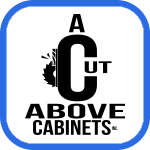Last month I discussed various methods to fill voids like a check, open knot or damaged area. The next step is to color and blend the filled areas.
I’ve had great success using colored pigments over the years. The process is reversible so at each step you can rework the color until it is just right. It is important to seal the wood first to bring out the surrounding color. I like to work with lacquers, but it can be done with other finishes.
Observation is the key. Seeing the subtle colors within the wood and visualizing how to create layers of color and grain detail is very important and takes a keen eye. This is more like artistic painting than woodworking and understanding some basic color theory and application techniques will make any repair easier to do.
Most common wood colors are on the red to yellow side of the primary color wheel and are often muted and dark, as with cherry and walnut. As a rule, I find that darker colors are easier to match than lighter ones like maple and oak.
In most cases it is easier to make the repair look like an existing knot or mineral stain, as opposed to attempting to make it look like the unblemished wood.
My technique
I rely on a small Blendal kit from Mohawk with the following colors: Black, Blue, Burnt Sienna, Burnt Umber, Canary Yellow, Dark Burnt Umber, Raw Sienna, Raw Umber, Red, Van Dyke Brown, White, and Yellow Ochre. I’ve added a green. With these colors I can match just about any type of wood.
But here’s a tip: After mixing, most colors are too saturated and need to be toned down. Adding grey (black and white) will not help as this will change the color. For example, deep red will become pink. Instead, add the complement color to the mix. A complement is the opposite on the color wheel: red/green, yellow/purple, orange/blue.
I use a No. 4 sable hair brush for the mixing and application. It holds enough pigment to make the repair without having to return for more color after every stroke and the tip is pointed enough to paint in fine grain lines.
To start mixing, I use an unwaxed 6 oz. white paper cup with a little wax-free shellac in the bottom. I dip my brush into the shellac, then the Blendal powder and apply to the inside rim of the cup. I repeat the process for a second color, leaving room between the two dabs for intermixing. I then mix the two in varying degrees until it looks right. With this process, I can create a large pallet of raw colors around the rim with combined intermixed colors in tone and value. When I think I have a good match I test it near the area I want to touch up. If the color is a good match, I immediately apply it to the repair. If the color isn’t quite right, I go back to the cup and adjust the color slightly.
I use shellac as a binder because it allows me to erase whatever I have done by simply wiping with a rag and alcohol. Another trick is after I am satisfied with the color, I seal it with a light coat of lacquer. This allows me to work on the second layer, but I can still erase it without affecting the first layer.
Most touchups require two or three layers of color, working from the lightest to darkest. I add some fine graining with the brush or a graining pen, which is a fine-tipped marker with similar pigments.
Other methods
There are a variety of application techniques you can use in addition to brushing. You can dab with your finger or rag to blend in or blur the painted line. Adding a puddle of alcohol before or after is great for blurring or creating a gradient of color, much like water coloring.
A common mistake is to apply too many layers, which will muddy the match or leave a noticeable mound.
If your existing finish is shellac, color matching and erasing becomes more tedious. I recommend testing the color match using a clear piece of Mylar on top of your project wood.
Most woods change in color over time, so you might have a perfect match one day and later the touchup looks lighter. With a high chatoyance wood, color touchups are almost impossible. Chatoyance is the shimmery, three-dimensional effect that you see in curly maple or ribbon-striped sapele. The effect is caused by how light reflects off the grain, making the wood look lighter or darker depending on the viewing angle.
In both scenarios, I don’t recommend trying to match the wood. Instead, I match an existing defect like a knot or mineral stain.
Other touchup tools include markers and colored pencils. Markers are available with or without a finish and are great for onsite repairs. Unfortunately, the tips harden with use and its more difficult to blend the finish. Markers without finish require a protective coating. Colored pencils are a good substitute in a pinch, but it is important to get soft lead types.
With these simple techniques and some practice, most repairs can be concealed and fixed with minimal effort.
Scott Grove is an art furniture maker, sculptor, and YouTube personality who selectively teaches and lectures, most notably at the Marc Adams School of Woodworking and The Chippendale School of Furniture in Scotland. For more, visit www.imaginegrove.com and www.scottgrove.com.
– –
Reference: Original Article
Reposted by: A Cut Above Cabinets
“Close to Heart” – Global Down Syndrome Foundation New Headquarters




